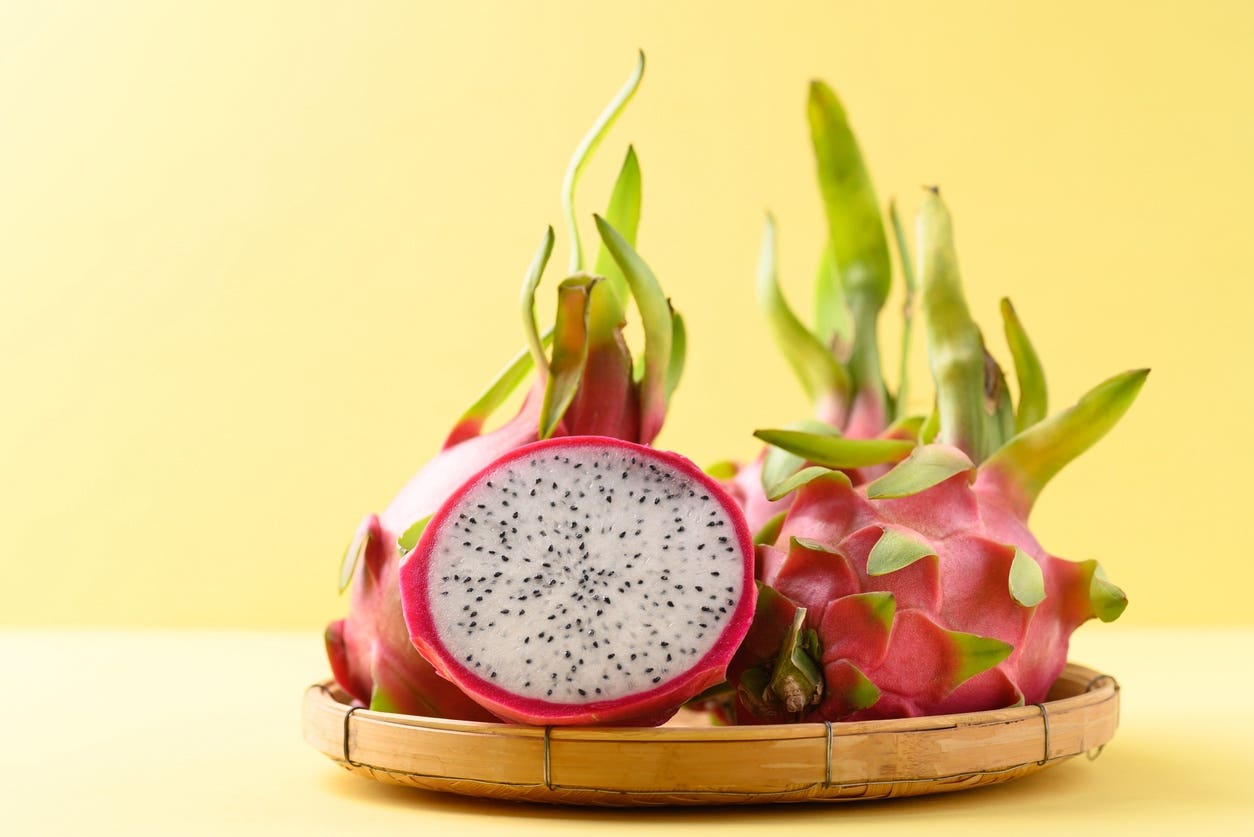
The Dish on Dragon Fruit: How to Select, Store, and Eat the Tropical Treat
Spiky, vibrant-hued dragon fruit is gorgeously alluring—but also a little intimidating. How do you pick a good one? A ripe one? Is scaly pink better than prickly yellow? And what’s the best way to cut that leathery rind and use the seed-speckled pulp? Here’s everything you need to know to take the guesswork out of selecting, prepping, storing, and savoring the tropical beauties so you can enjoy them whenever you find them.
What Is Dragon Fruit, and Where Does It Come From?
Dragon fruit, also called pitaya, pitahaya, and strawberry pear, are cactus fruits that develop on the tips of large, lobed cactus vines (Selenicereus undatus) native to Central America. The fruits are cultivated in tropical regions around the world. They are especially popular in Southeast Asia, which is where their name comes from. According to one legend from the region, the oblong, scaly-skinned fruit appears with the last fiery breath of a dying dragon.
Dragon fruit has become increasingly popular and accessible in North America, thanks to farms in Florida and California and imports from South and Central America. They are available year-round, with a peak season in August and September. Despite their thick skins, dragon fruits are delicate and easily bruised, which is why they can be pricey and are often sold in protective packaging.
Dragon Fruit Varieties
There are four different types of dragon fruits: white, red, purple, and yellow. Identification can get a little confusing, because white, red, and purple dragon fruits get their names from the color of the flesh inside. Yellow dragon fruits are the only type named for their exterior.
White Dragon Fruit
White dragon fruit has a magenta-pink exterior with green-tipped scales. Inside is a creamy white flesh flecked with black seeds, which has a mild, sweet taste that has a hint of kiwi tartness. The most common dragon fruit variety, it’s larger, heavier, and often less expensive than other varieties.
Red Dragon Fruit
Highly sought-after for its fuchsia-pink interior flesh, red dragon fruit tends to be smaller and more oval-shaped than white dragon fruit but otherwise has a very similar-looking exterior. Often, the label is the only way to differentiate between the two unless they are cut open. Red dragon fruit has a higher sugar content than white, which lends it a rich, berry-like sweetness.
Purple Dragon Fruit
A rare beauty that falls somewhere between white and red, taste-wise, purple dragon fruit has a bright magenta exterior and neon pinkish-purple flesh inside.
Yellow Dragon Fruit
Spiky, canary-yellow dragon fruit are smaller and sweeter than their red-skinned cousins, with a white, occasionally translucent flesh that is especially juicy.
How to Select and Store Dragon Fruit
Look for dragon fruit with vibrantly colored skin and firm, intact scales. Hold the fruit in your hand; it should feel heavy for its size. Test the spiky tip to see that it is supple and pliable, not hard or woody. Gently press the fruit’s skin to be sure it has a little give, a sign that the flesh inside will be soft and juicy.
If the dragon fruit feels firm and not quite ripe, store it at room temperature for two to three days to let it ripen. After that, refrigerate dragon fruit for up to five days.
You can also freeze peeled, cut dragon fruit. (And you can purchase cubed dragon fruit in the frozen food section of some supermarkets.)
3 Ways to Prepare Dragon Fruit
Always wash dragon fruit before you cut it to remove any dust or dirt that can get lodged in its thick skin in transit. After that, the fruit is as easy to prep as an avocado—without any pesky pit to deal with. Here are three easy ways to do it.
Halve and Scoop
Place the fruit on a cutting board and halve it lengthwise. Slide a large spoon between the skin and the flesh of each half, then use the spoon to scoop out the speckled flesh. Slice or cut into cubes. Added bonus: The washed, scooped-out skins can be used as pretty serving bowls. Alternately, you can serve the halved fruit as is and scoop out the flesh with a spoon.
Trim and Peel
Cut each end off the fruit, then score the skin with a lengthwise cut through without cutting into the flesh. Peel off the skin the way you would peel an orange, then cut the dragon fruit into rounds, slice into wedges, or dice.
Slice Into Wedges
Wash fruit, leaving skin on. Cut fruit in half lengthwise, then cut each half into four wedges for perfect, colorful pieces to eat like slices of melon.
Dragon Fruit Recipe Recommendations
Dragon fruits are sweet and juicy like a perfectly ripe pear, with a distinctive, seedy crunch similar to a kiwi. That crunch is a welcome addition to salads, breakfast bowls, and other fruity recipes, like our Mixed Fruit Soup. Try adding diced dragon fruit to a Rainbow Fruit Platter with Citrus Drizzle. You can also blend it in place of mangoes in a smoothie bowl. Or just enjoy dragon fruit on its own as a refreshing dessert or a snack.
About the Author

About the Author
Mary Margaret Chappell
Join our mailing list
Get free recipes and the latest info on living a happy, healthy plant-based lifestyle.
By providing your email address, you consent to receive newsletter emails from Forks Over Knives. We value your privacy and will keep your email address safe. You may unsubscribe from our emails at any time.
